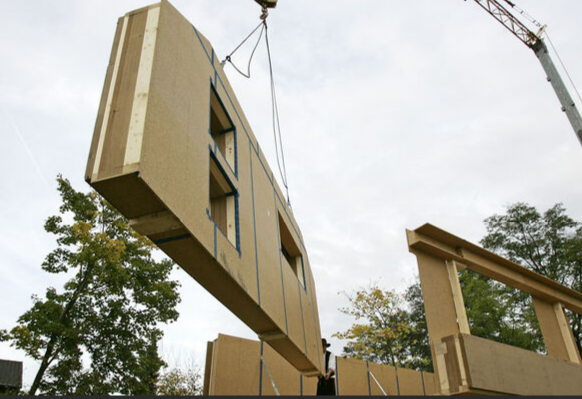
Timber construction has growth potential.
There is strong investment in serial timber and modular
construction - regardless of the size of the company. However,
while the construction industry continues to weaken, the
question is growing: when will the market actually need the new
capacities?
In the recent past, the news of new, huge production facilities
for serial timber construction and modular construction has
literally come thick and fast. Up to 30,000 residential units
per year are to be built at the Nokera site in Möckern, which
will open in 2024. In Richen, Gropyus is currently launching a
€300 million robot production facility that will produce a wall
or ceiling element every 16 minutes in future. An annual output
of 250,000 m2 of gross floor area is targeted - the degree of
automation is to be increased to up to 86%. Timpla by Ren ggli
plans to produce up to 2,000 modules per year in Eberswalde,
Germany, while Kaufmann Bausysteme now produces up to 4,000
modules per year at three locations and handles large
construction sites with 500 to 1,000 modules in Berlin and other
major German cities. In Austria, Binderholz has realised a
production facility for system construction with b-solution in
Hallein, where room modules with complete building services
installations and wet rooms are manufactured in addition to
prefabricated wall modules, ceilings and roofs. The company
estimates its annual capacity at 130,000 m2 of gross floor area.
More than the above-mentioned and other announced mega projects,
however, it is large and medium-sized timber construction
companies in particular that are increasingly shifting their
work from the construction site to the hall and steadily
increasing the level of prefabrication. In addition to
two-dimensional wall and ceiling elements as well as
three-dimensional room modules, the serial refurbishment of an
outdated building stock is also playing an increasingly
important role.
Lots of demand - little construction activity
All of this is taking place against the backdrop of a weak
construction industry and a recent massive decline in building
permits in Germany and Austria. This contrasts with a blatant
housing shortage in Germany, which has now grown to over 800,000
units.
It is therefore only a matter of time before the construction
sector picks up again and the capacities that are now being
created are actually needed, according to some industry experts,
or as one market participant who recently started up put it: ¡®We
may have started two years too early, but if we only started
now, we would probably be two years too late.¡¯
In addition to the difficult market environment, this statement
also implies the fact that new production lines and business
models are by no means plug & play solutions. With increasing
size and a high degree of automation, the time required for
commissioning also increases significantly. It can therefore
take several years before the targeted performance is actually
realised.
Numerous market participants are currently reporting a
satisfactory order situation, with the focus often being on
public projects such as kindergartens and schools, as well as
hotel projects and commercial buildings, and residential
construction is also slowly picking up again.
Making the best possible use of advantages
The most important factors for the success of a project are
repeatedly cited as good and comprehensive planning and optimum
preparation of the construction site. This is because serial
timber construction can only fully utilise one of its greatest
advantages - the shorter construction time - if no unnecessary
time is lost on the construction site. In order to achieve this,
good partnerships with concrete constructors or the development
towards becoming a general contractor are required - a path that
many companies in this segment have already successfully taken
and which is also highly valued by clients due to the simpler
communication and project management.
Serial timber construction benefits from a significant speed
advantage and a continuous increase in labour productivity
compared to concrete and brick construction. It also offers
numerous other advantages. Even in economically challenging
times, it is therefore increasingly gaining market share. When
the construction industry picks up speed again, serial timber
construction could therefore play a key role - and by then at
the latest it will be clear who has done their homework and
which of the new production capacities can hold their own on the
market.
Source: holzbauaustria.at